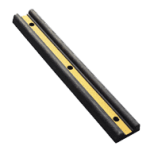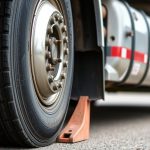Introduction
Importance of choosing the right speed bumps
Choosing the right speed bumps for your property is crucial for ensuring the safety of drivers, pedestrians, and property. Speed bumps that are too high or too steep can cause damage to vehicles and discomfort to passengers, while those that are too low or too shallow may not effectively slow down speeding drivers. Additionally, selecting the appropriate speed bumps can help to reduce noise pollution and improve the overall appearance of your property. By taking the time to carefully consider your options and choose the right speed bumps, you can create a safer and more comfortable environment for everyone who uses your property.
Factors to consider
When choosing the right speed bumps for your property, there are several factors to consider. Firstly, you need to think about the speed limit on your property and the type of vehicles that will be using the speed bumps. The height and width of the speed bumps should be appropriate for the speed limit and the size of the vehicles. Secondly, you need to consider the location of the speed bumps and the traffic flow. The speed bumps should be strategically placed to slow down traffic in high-risk areas such as pedestrian crossings and parking lots. Lastly, you need to think about the material of the speed bumps. Rubber and plastic speed bumps are popular choices as they are durable, easy to install and maintain, and provide good visibility.
Types of Speed Bumps
Traditional Speed Bumps
Traditional speed bumps are the most common type of speed bump and are typically made of asphalt or concrete. They are designed to slow down vehicles to a speed of 5-10 mph. Traditional speed bumps are effective at reducing speed, but they can be uncomfortable for drivers and passengers, especially if they are driving over them frequently. Additionally, they can cause damage to vehicles if drivers do not slow down enough before driving over them. It is important to consider the frequency and speed of traffic on your property before deciding if traditional speed bumps are the right choice for you.
Speed Humps
Speed humps are another option for slowing down traffic on your property. Unlike speed bumps, which are typically shorter and steeper, speed humps are longer and more gradual. This allows vehicles to maintain a slightly higher speed while still slowing down overall. Speed humps are often used in areas where there is a higher volume of traffic, such as parking lots or private roads. They can also be a good choice for areas where emergency vehicles need to maintain a certain speed. When choosing speed humps, it’s important to consider the length and height of the hump, as well as the spacing between them. Proper placement and spacing can help ensure that drivers slow down without causing unnecessary discomfort or damage to their vehicles.
Speed Cushions
Speed cushions are another option for traffic calming measures. They are similar to speed humps but have a wider profile and a gap in the middle to allow larger vehicles, such as emergency vehicles and buses, to straddle them without slowing down. Speed cushions are often used in areas where emergency vehicle access is important, such as near hospitals or fire stations. However, they may not be as effective at slowing down traffic as speed humps, as some drivers may still be able to drive over them at higher speeds. It is important to consider the specific needs and goals of your property when deciding between speed humps and speed cushions.
Rolling Bumps
Rolling bumps are a type of speed bump that is designed to allow vehicles to pass over them at a higher speed than traditional speed bumps. These bumps are typically made of a series of small, rounded bumps that are spaced out along the road. Rolling bumps are ideal for areas where traffic needs to slow down, but where it is also important to maintain a steady flow of traffic. They are often used in parking lots, driveways, and other areas where vehicles need to slow down to avoid accidents. When choosing rolling bumps, it is important to consider the size and weight of the vehicles that will be using the area, as well as the speed at which they will be traveling.
Portable Speed Bumps
Portable speed bumps are a great option for those who need a temporary solution or want the flexibility to move the speed bumps around as needed. These speed bumps are typically made of durable materials such as rubber or plastic and can be easily transported and installed without the need for heavy machinery or professional installation. Portable speed bumps are ideal for events, construction sites, and other temporary situations where traffic calming measures are necessary. It is important to note that portable speed bumps may not be as effective as permanent speed bumps, so it is important to consider the specific needs of your property before choosing this option.
Factors to Consider
Traffic Volume
Traffic volume is an important factor to consider when choosing the right speed bumps for your property. If your property experiences high traffic volume, it is recommended to install speed bumps that are larger and more visible to ensure maximum safety. On the other hand, if your property experiences low traffic volume, smaller speed bumps may be sufficient. It is important to assess the traffic volume on your property and choose speed bumps accordingly to ensure the safety of drivers, pedestrians, and property.
Vehicle Speed
When considering the right speed bumps for your property, it’s important to take into account the average speed of vehicles in the area. If vehicles are traveling at high speeds, it may be necessary to install larger, more pronounced speed bumps to effectively slow them down. On the other hand, if vehicles are traveling at slower speeds, smaller speed bumps may be sufficient. It’s also important to consider the type of vehicles that will be using the area, as larger vehicles may require more heavy-duty speed bumps to effectively slow them down. Ultimately, choosing the right speed bumps for your property will depend on a variety of factors, including vehicle speed, traffic volume, and the specific needs of your property.
Vehicle Type
When choosing the right speed bumps for your property, it’s important to consider the types of vehicles that will be using them. If your property is primarily used by passenger vehicles, then a standard speed bump with a height of 3-4 inches and a length of 6-8 feet may be sufficient. However, if your property sees a lot of commercial vehicles or heavy trucks, you may want to consider using larger speed bumps with a height of 6-8 inches and a length of 10-14 feet to ensure they slow down enough to prevent damage to your property or other vehicles. It’s important to choose speed bumps that are appropriate for the types of vehicles that will be using them to ensure maximum effectiveness and safety.
Pedestrian Traffic
When it comes to pedestrian traffic, it’s important to choose speed bumps that are low-profile and have a gradual incline. This will ensure that pedestrians can easily walk over them without tripping or stumbling. Additionally, it’s important to consider the location of the speed bumps in relation to crosswalks and other pedestrian areas. Installing speed bumps too close to these areas can create a safety hazard and increase the risk of accidents. Overall, prioritizing pedestrian safety and accessibility should be a top consideration when selecting speed bumps for your property.
Drainage
Drainage is an important factor to consider when choosing speed bumps for your property. If your property is prone to flooding or has poor drainage, it’s important to choose speed bumps that won’t impede water flow. Look for speed bumps with built-in drainage channels or ones that are designed to allow water to flow freely underneath. Additionally, it’s important to ensure that the speed bumps are installed in a way that won’t create additional drainage issues. Consider consulting with a professional to ensure that your speed bump installation won’t negatively impact your property’s drainage.
Accessibility
Accessibility is a crucial factor to consider when choosing the right speed bumps for your property. It is important to ensure that the speed bumps do not create any barriers for people with disabilities, including those who use wheelchairs or mobility aids. The speed bumps should be designed in a way that allows for easy passage for all individuals, without causing any discomfort or inconvenience. Additionally, it is important to ensure that the speed bumps are clearly marked and visible, to prevent any accidents or injuries. By taking these factors into consideration, you can choose speed bumps that are safe and accessible for everyone who uses your property.
Cost
Cost is an important factor to consider when choosing the right speed bumps for your property. The price of speed bumps can vary depending on the material, size, and installation method. Rubber speed bumps are typically less expensive than concrete ones, but they may not be as durable. Concrete speed bumps, on the other hand, are more durable but can be more expensive to install. It’s important to weigh the cost against the benefits of each type of speed bump to determine which option is the best fit for your property. Additionally, it’s important to factor in the cost of maintenance and repairs over time to ensure that you are making a wise investment.
Choosing the Right Speed Bumps
Assessing your property
Before choosing the right speed bumps for your property, it is important to assess the layout and traffic flow of your property. Take note of any high-traffic areas, blind spots, and potential hazards such as sharp turns or narrow passages. Consider the speed limit of your property and the type of vehicles that will be using it. Additionally, take into account any pedestrian traffic and the proximity of buildings or other structures. By assessing your property thoroughly, you can determine the most effective placement and type of speed bumps to ensure the safety of all users.
Consulting with experts
Consulting with experts is an important step in choosing the right speed bumps for your property. Experts can provide valuable insights into the types of speed bumps that are most effective for your specific needs. They can also help you determine the appropriate placement and spacing of speed bumps to ensure maximum safety and efficiency. Additionally, experts can advise you on any local regulations or requirements that may impact your speed bump installation. By working with experts, you can feel confident that you are making the best decisions for your property and the safety of those who use it.
Selecting the appropriate type
When selecting the appropriate type of speed bump for your property, it is important to consider the speed limit and traffic flow of the area. For high traffic areas with a speed limit of 25 mph or less, a traditional speed bump may be the best option. For areas with higher speed limits or heavy truck traffic, a more heavy-duty option such as a speed hump or speed cushion may be necessary. Additionally, it is important to consider the material of the speed bump, as rubber and plastic options are more flexible and forgiving, while concrete options are more durable and long-lasting. Ultimately, selecting the appropriate type of speed bump will depend on the specific needs and characteristics of your property.
Installation and maintenance
Once you have chosen the right speed bumps for your property, it is important to ensure that they are installed correctly and maintained regularly. Improper installation can lead to safety hazards and damage to vehicles, while neglecting maintenance can result in the speed bumps becoming ineffective over time. It is recommended to hire a professional to install the speed bumps and to regularly inspect and clean them to ensure they are functioning properly. Additionally, any necessary repairs should be made promptly to prevent further damage and maintain the safety of drivers and pedestrians. By taking these steps, you can ensure that your speed bumps are effective in slowing down traffic and promoting safety on your property.
Conclusion
Summary of key points
In summary, choosing the right speed bumps for your property requires careful consideration of several factors. The size and weight of vehicles that will be using the area, the speed limit, and the frequency of traffic are all important considerations. Additionally, the type of speed bump, such as rubber or asphalt, and the installation method, such as glue-down or bolt-down, should also be taken into account. By carefully evaluating these factors, you can select the speed bumps that will best meet the needs of your property and help ensure the safety of drivers and pedestrians alike.
Final thoughts
In conclusion, choosing the right speed bumps for your property is crucial for ensuring the safety of drivers, pedestrians, and property. By considering factors such as traffic volume, speed limits, and the type of vehicles that will be using the area, you can select the most appropriate speed bumps for your specific needs. Remember to also consider the installation process and maintenance requirements to ensure that your speed bumps remain effective and in good condition for years to come. With the right speed bumps in place, you can create a safer and more efficient environment for everyone who uses your property.






